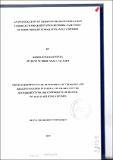| dc.description.abstract | ABSTRACT
TITLE: AN INVESTIGATION OF CHRISTIAN RELIGIOUS EDUCATION CURRICULUM IMPLEMENTATION METHODS: A CASE STUDY OF THREE PRIMARY SCHOOLS IN KANGETA DIVISION.
AUTHOR: KIRIMI JONATHAN MWENDA
Christian Religious Education remains one of the most single subjects that deal directly with the teaching of spirituality, values, attitudes, beliefs and human behavior with the Bible as the key resource. Teaching of CRE in Kenya has undergone tremendous changes over the years. Defective curriculum can lead to defective teaching, which eventually affect the pupils as well as the country. There is problem when it comes to the implementation of CRE curriculum in primary schools. According to reliable information from the District Education Office, there has been no documented study done in Kangeta Division investigating CRE curriculum implementation methods. The main objective of the study was therefore an investigation of CRE curriculum implementation methods: A case study of three selected primary schools in Kangeta Division. The three schools that were included in the study were: Njia primary school, Kani-Karui primary school and Kangeta primary school. The research sought to answer four main questions: What are the methods used in primary schools during CRE curriculum implementation? What is the level of training of CRE curriculum implementers in the relevant subject in primary schools? What is the quality of CRE teaching and learning instructional materials being used in primary schools? What are the sources of CRE instructional materials in primary schools? The research design used was a case study where both quantitative and qualitative descriptive study was adopted. The researcher used questionnaires, face-to-face interviews and observation methods. The study was carried out in Kangeta division, Igembe south district which is about 54 kilometers North of Meru Town. Pupils and teachers of CRE of the three selected primary schools in Kangeta Division served as the population in the study. The raw data obtained was put into tables using calculators, computers, and then presented in form of percentages, pie charts and graphs. The study finding revealed that schools had adequate instructional and learning materials for CRE instructional materials. From the study it was established that the CRE teachers involved the learners when teaching in reading the Bible, asking and answering questions and role playing some of the bible characters. Even though the three schools indicated that they had adequate instructional materials for teaching CRE, the schools management and community leaders should work closely to strengthen their relations which will make the provision of basic teaching facilities and resources possible. This in turn makes it possible for the schools to attain better performance. | en_US |

